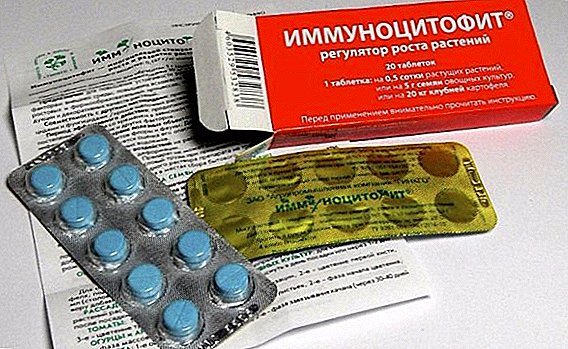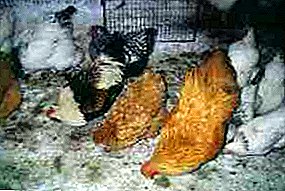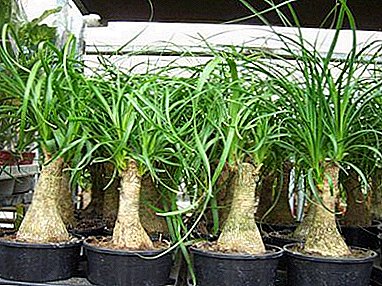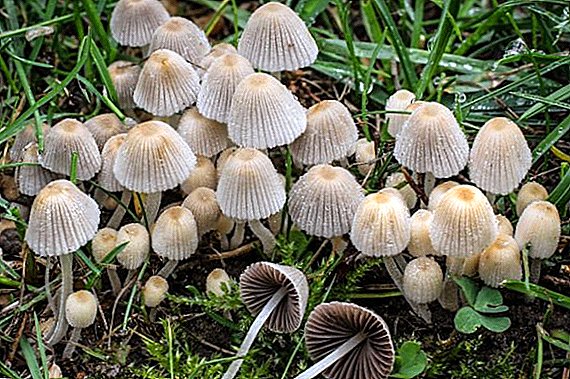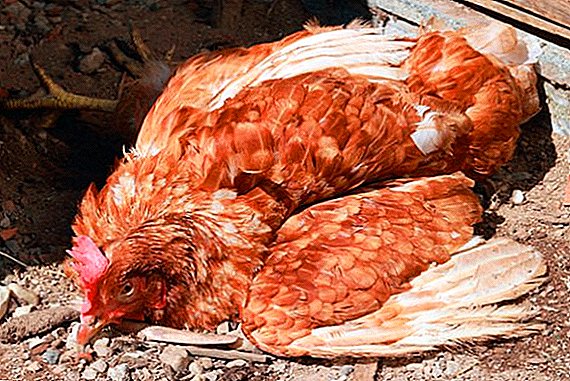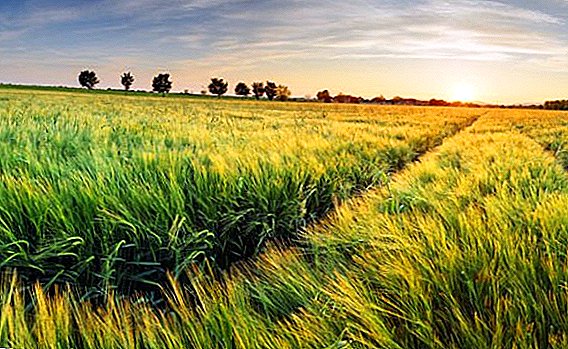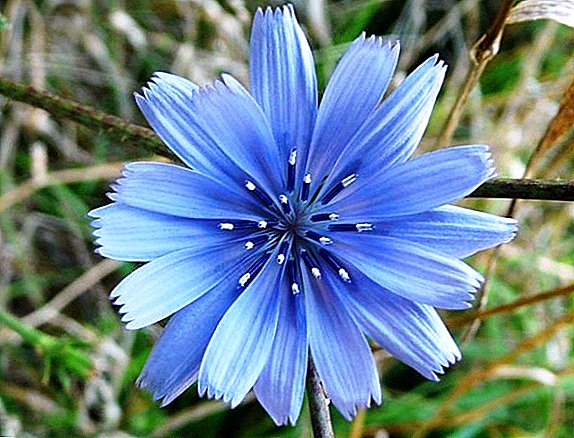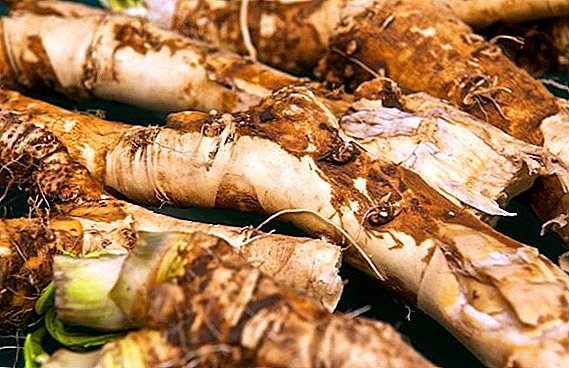 Perhaps, there will be no more such vegetable with which in the Russian language there would be so many sayings, stable expressions and curses, like horseradish. First of all, they emphasize the sharp and bitter taste of this plant. Meanwhile horseradish (lat. Armorácia) - spicy seasoning, very useful for humans, with many healing properties. Therefore, it is always unpleasant when the plant itself becomes ill. On the methods of combating diseases and pests of horseradish, we now talk.
Perhaps, there will be no more such vegetable with which in the Russian language there would be so many sayings, stable expressions and curses, like horseradish. First of all, they emphasize the sharp and bitter taste of this plant. Meanwhile horseradish (lat. Armorácia) - spicy seasoning, very useful for humans, with many healing properties. Therefore, it is always unpleasant when the plant itself becomes ill. On the methods of combating diseases and pests of horseradish, we now talk.
Horseradish pest control methods
Horseradish is often grown in vegetable gardens and suburban areas, and the process of breeding this herbaceous perennial is not difficult - horseradish is unpretentious either to the soil, or to care, or to watering and fertilizer. The main purpose of its cultivation is the usefulness of the root.
Unfortunately, not only people, but also insects, who also prefer to eat it as food, than strongly damage the plant, consider it useful. We offer to get acquainted with the most common horseradish pests and methods to combat them.
Babanuha
 He likes to feast on leaves of horseradish, as, incidentally, all other plants from the cabbage family, babana or cabbage (horseradish) leaf beetle. It is these small (3-4 cm) dark greenish beetles and their larvae gnaw the foliage so that sometimes one sieve is left from the leaves. In early June, in search of food, these beetles leave wintering grounds.
He likes to feast on leaves of horseradish, as, incidentally, all other plants from the cabbage family, babana or cabbage (horseradish) leaf beetle. It is these small (3-4 cm) dark greenish beetles and their larvae gnaw the foliage so that sometimes one sieve is left from the leaves. In early June, in search of food, these beetles leave wintering grounds.
The females lay eggs in the eaten sheet plates and the new offspring appears as early as August, damaging the plant over a three-week period. After that, the insects begin the process of pupation.
Methods of struggle. If you find extra holes on the plant, but you can’t understand why the horseradish leaves are all in holes, we advise you to immediately remove the damaged parts. In case of a massive defeat of a plant, it will be necessary to carry out a deep digging of the soil, followed by treatment with insecticides. To do this, fit drugs "Fury", "Aktellik", "Karbofos", "Inta-vir" and others.
Important! To begin with, it was recommended to test chemical preparations on one bush only, and in a day, if no undesirable reactions happened, all plants are processed.
With an insignificant spread of pests, mechanical processing is recommended — the collection of beetles and larvae by hand and shaking them onto a litter. Also well proven and glue traps.
As an alternative method of dealing with babanukha, dusting can be carried out with a dry mixture, which consists of: 1 cup of wood ash, 1 teaspoon of dry mustard and ground red pepper. This treatment should be carried out at least three times with an interval of 4-5 days. From plant insecticides recommended treatment with decoctions of yarrow, chamomile, sage.
Did you know? The effectiveness of preparations made by hand, is 30-40%. To achieve a higher result, plants are treated with broths and infusions at least three times at intervals of 5-7 days. In case of mass pest damage, it is better to use bio-antiparasitic drugs.
Since the beetles hibernate under unclean foliage and in the soil near the roots, in order to prevent an invasion of cabbage or horseradish leaf beetles, in the autumn period you need to remove dry plant residues, dig the soil in the root zone and also remove weeds in time.
Wavy flea
 Another unpleasant guest for a vegetable garden where horseradish grows, often becomes a wavy flea. This microscopic size (3 mm) beetle can cause great damage to the plant. It can be recognized by its black color and yellow stripes on its sheaths. Just like babanaha, the flea eats leaves, eating out through holes in them. It begins its sabotage in the first month of spring. The females lay eggs on the soil surface, causing horseradish leaves to dry out and the plant to die.
Another unpleasant guest for a vegetable garden where horseradish grows, often becomes a wavy flea. This microscopic size (3 mm) beetle can cause great damage to the plant. It can be recognized by its black color and yellow stripes on its sheaths. Just like babanaha, the flea eats leaves, eating out through holes in them. It begins its sabotage in the first month of spring. The females lay eggs on the soil surface, causing horseradish leaves to dry out and the plant to die.
Methods of struggle. In order not to let the wavy flea in your garden, in late autumn you need to remove dry leaves and carefully dig the soil. Also recommended periodic loosening of the soil under horseradish during its growth. Since before the appearance of leaves of cultivated plants, pests feed on weeds, we must get rid of them in a timely manner.
If the wavy flea still occupied your area, then for the treatment of horseradish from these pests, you can use the drugs "Foksim" and "Aktellik". Spraying is carried out three times: in the period of emergence of sprouts, at the beginning of the nomination of buds and after flowering. You can also use vegetable insecticides - in this case, you should choose drugs that contain tobacco in their composition.
Also, an effective way would be to use sticky traps (made of glue, honey, grease, etc.) applied to the leaves of the plant or paper caps to cover horseradish.
Important! When carrying out spraying it is necessary to adhere to security measures. Processing should be carried out in calm weather, hands should be protected by gloves, eyes - glasses, and nose and mouth - a mask.
From folk remedies you can try dusting a dry mixture of ash, mustard and red pepper (prepared as in the fight with babanukha). Also popularly used spraying a solution of vinegar (1 cup of 9% vinegar in a bucket of water), garlic-tomato infusion (and 1 cup of chopped garlic and tomato tops to dissolve in 10 liters of warm water, add laundry soap), a decoction of tansy.
Cabbage Mace
 Horseradish larvae are also enemies of the moth - cabbage moth. The butterfly itself is small and with a wingspan of 3 cm. It has a brown body with dark stripes on the front wings. Caterpillars winter in the soil, and come to the surface in June, after which butterflies immediately appear. Females lay eggs on the underside of the leaf. After 10 days there is a voracious offspring, which gnaws the leaves of horseradish for a month. Then it goes into the ground for pupation and wintering.
Horseradish larvae are also enemies of the moth - cabbage moth. The butterfly itself is small and with a wingspan of 3 cm. It has a brown body with dark stripes on the front wings. Caterpillars winter in the soil, and come to the surface in June, after which butterflies immediately appear. Females lay eggs on the underside of the leaf. After 10 days there is a voracious offspring, which gnaws the leaves of horseradish for a month. Then it goes into the ground for pupation and wintering.
Methods of struggle. Preventive measures against these horseradish pests are used the same as in the attacks of the parasites described above. Horseradish should be planted as soon as possible - before the appearance of butterflies. For mass infections, anti-parasitic insecticide treatments are used.
Cabbage bug
 The symptom that your horseradish is struck by the cabbage bug will be yellowed leaves, on which dying spots will later appear. The adult bug has a flat red body with black spots 8-10 cm long. The females lay eggs on the underside of the leaf plate. The active development of larvae occurs in the first month of summer, with the onset of the first hot days. The larvae and adults suck the juice from the leaves and shoots. Hibernate in post-harvest residues.
The symptom that your horseradish is struck by the cabbage bug will be yellowed leaves, on which dying spots will later appear. The adult bug has a flat red body with black spots 8-10 cm long. The females lay eggs on the underside of the leaf plate. The active development of larvae occurs in the first month of summer, with the onset of the first hot days. The larvae and adults suck the juice from the leaves and shoots. Hibernate in post-harvest residues.
Methods of struggle. To successfully combat this parasite, it is necessary to carry out preventive measures in the form of early sowing, periodic digging, destruction of weeds and plant residues after harvest.
You can also use repellents (in particular, the treatment of leaves with soapy water: 300 g of soap are diluted in a bucket of water) or use dry treatment with ashes mixed with sand and naphthalene, or tobacco mixed with sand and earth. Spraying with chamomile, onion peel decoctions gives a good effect.
In case of mass destruction by a bug (two or more individuals per bush), the insecticides “Actellic”, “Phosbecid”, “Belofos”, etc. are used.
Important! Eating plants treated with chemicals can be no earlier than 30 days after spraying.
Ways to fight horseradish diseases
In addition to pests, horseradish affects a number of ailments. The most dangerous of them are verticillary wilting and white rust.
Ascohitoz horseradish
 The main symptoms of horseradish ascochitis are large yellowish-brown spots on the leaves. On the affected areas appears mycelium, where the fungus is the causative agent winters. In the future, the sheets dry out and fall off. A pathogenic fungus loves to grow in a humid environment, and is also able to remain in post-harvest residues, soil, seeds for a long time.
The main symptoms of horseradish ascochitis are large yellowish-brown spots on the leaves. On the affected areas appears mycelium, where the fungus is the causative agent winters. In the future, the sheets dry out and fall off. A pathogenic fungus loves to grow in a humid environment, and is also able to remain in post-harvest residues, soil, seeds for a long time.
Methods of struggle. To preventive measures against ascohitosis include the observance of crop rotation, autumn harvesting and plowing the vegetable garden. For the treatment of the disease, the affected leaves are removed, treatment with 1% Bordeaux fluid or its substitutes is used. Note that it is better to spray twice, at intervals of one week.
White rot
 White rot is an infectious fungal disease that affects horseradish leaves and roots (they are covered with white mycelium and black sclerotia). In the presence of ailment, the plant quickly fades and dies. The mushroom-parasite actively develops in especially wet periods, in densely mounted horseradish or in soil over-fertilized with nitrogen.
White rot is an infectious fungal disease that affects horseradish leaves and roots (they are covered with white mycelium and black sclerotia). In the presence of ailment, the plant quickly fades and dies. The mushroom-parasite actively develops in especially wet periods, in densely mounted horseradish or in soil over-fertilized with nitrogen.
Methods of struggle. Preventive measures against this disease involve the elimination of favorable factors for the development of the fungus, that is, you will be required to:
- make sure that the soil under horseradish was not overwetted;
- plant horseradish bushes at a distance of 30-50 cm from each other; row spacing must be at least 60-70 cm;
- feed the plant with balanced fertilizers;
- time to remove weeds;
- lime sour soil;
- buy seeds only in proven specialized stores.
Did you know? If horseradish in your garden has already been hit by white rot, then plant it on the same plot only after 3-4 years.
Belle
 If you notice that the leaves, stems, pedicels, testes of your plant are covered with bloom, similar to white oil paint, it means that your horseradish was struck by belle. As the disease progresses, the plant's organs turn brown and die. The pathogen is transported with post-harvest residues.
If you notice that the leaves, stems, pedicels, testes of your plant are covered with bloom, similar to white oil paint, it means that your horseradish was struck by belle. As the disease progresses, the plant's organs turn brown and die. The pathogen is transported with post-harvest residues.
Methods of struggle. In case of severe injury, spraying with copper preparations is used.
Verticillary wilting
With verticillary wilt, the fungus-pathogen penetrates into the vascular system of horseradish. First, the lower leaves wither, and then gradually the whole plant. Spores of the fungus overwinter in the soil, and may persist there for several years.
Methods of struggle. If you suspect this disease, you must inspect the beds every 10 days, and remove diseased plants along with the layer of earth beneath them. After watering, deeply loosen the soil, as well as carefully destroy the remnants of plants after harvest and deeply dig the soil.
Downy mildew
 Downy mildew or horseradish perinosporosis infects the leaves. First, they are covered with light green or yellowish spots, and on the back of the sheet plate forms a gray or whitish coating. Then the spots merge together, the leaves become brown in color and die. The plant becomes weak and gives a small root vegetable.
Downy mildew or horseradish perinosporosis infects the leaves. First, they are covered with light green or yellowish spots, and on the back of the sheet plate forms a gray or whitish coating. Then the spots merge together, the leaves become brown in color and die. The plant becomes weak and gives a small root vegetable.
Methods of struggle. Since the main way of infecting plants with this fungal disease is affected seeds, they must be decontaminated before planting. At the first signs of the disease, diseased plants should be removed, and in the case of extensive spread of the disease, spraying with copper-containing fungicides is recommended.
Significantly reduce the risk of diseases and attacks of pests can be, caring for their garden and plants, making them strong and resistant. Preventive measures will be:
- crop rotation and fruit change;
- thorough weeding and weed control;
- watering with cool water with the addition of plant insecticides;
- fertilizer;
- autumn harvesting of crop residues;
- deep digging soil.
All this will also help avoid the use of chemicals.


